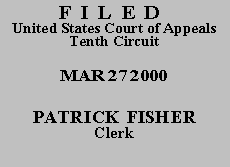 UNITED STATES COURT OF APPEALS
UNITED STATES COURT OF APPEALS
 UNITED STATES COURT OF APPEALS
UNITED STATES COURT OF APPEALS
TENTH CIRCUIT
| UNITED STATES OF AMERICA, | |
| v. | No. 99-2191 |
| BEN GALLEGOS, | (D.C. No. CR-97-737-JC)
(D.N.M.) |
ORDER AND JUDGMENT(*)
Before BALDOCK,HOLLOWAY, and EBEL, Circuit Judges.
Defendant Ben Gallegos appeals the district court's denial of his motion to suppress evidence seized during a search of his auto paint and body shop. Defendant alleges that the officers did not knock and announce before entering. A jury convicted Defendant of possession of methamphetamine in violation of 21 U.S.C. § 841(a)(1). We exercise jurisdiction pursuant to 28 U.S.C. § 1291, and affirm.
I.
On November 18, 1997, at 5:30 p.m., a group of Albuquerque Police Department (APD) officers, including a SWAT team, several members of APD's Repeat Offenders Project, and several Drug Enforcement Agency Task Force officers, executed a search warrant at Defendant's auto paint and body shop. The marked vehicles traveled in a convoy with their emergency lights flashing and parked roughly twenty yards from the building. The officers believed that surveillance cameras were monitoring the building's exterior. A window overlooked the street where the officers' vehicles were parked.
The SWAT team members exited their van and broadcast on the public address system that they were executing a warrant on the building. No one from inside responded or came to open the door. After repeating the message for about five minutes, the SWAT team approached the door. While beating on the door and shouting "Police officers, search warrant," the officers fired flash-bang grenades into the building and used a rescue tool to force the door open. Subsequently, the officers found Defendant inside the building, hiding in a closet. Defendant told the officers that methamphetamine and cash were located in an upstairs office. The officers seized the drugs and money and arrested Defendant.
II.
Defendant appeals the district court's denial of his motion to suppress the evidence seized at the auto paint and body shop. In reviewing the denial of a motion to suppress, we review the evidence in a light most favorable to the government and review the district court's factual findings only for clear error. United States v. Jenkins, 175 F.3d 1208, 1212 (10th Cir.), cert. denied, 120 S. Ct. 263 (1999). Because the district court made no specific findings in support of its denial of the motion, we must uphold the ruling if any reasonable view of the evidence supports it. Id. The district court's determination as to ultimate reasonableness of the search is a question of law which we review de novo. Id.
The federal knock and announce statute is not directly applicable to state officers, but it serves as a guide to determining reasonableness under the Fourth Amendment. United States v. McCloud, 127 F.3d 1284, 1286 n.1 (10th Cir. 1997). The statute provides:
The officer may break open any outer or inner door or window of a house, or any part of a house, or anything therein, to execute a search warrant, if, after notice of his authority and purpose, he is refused admittance or when necessary to liberate himself or a person aiding him in the execution of the warrant.
18 U.S.C. § 3109. "[T]he amount of time that officers must wait after knocking and announcing depends on the particular facts and circumstances of each case." Jenkins, 175 F.3d at 1213. "[T]he reference point for the reasonableness determination is the amount of time between when the officers begin to announce their presence and when the officers hit the door with a battering ram or other implement which could destroy the door and allow them entry." McCloud, 127 F.3d at 1288 n.2.
III.
In this case, the district court correctly denied Defendant's motion to suppress because the officers reasonably executed the search warrant on Defendant's auto paint and body shop. The record reveals that the officers approached the building en masse in marked cars with emergency lights flashing, a display that would reasonably have been visible on the surveillance cameras or through the windows. About five minutes passed between the time the officers began broadcasting on the public address system and the time they applied the tool to force open the door. See McCloud, 127 F.3d at 1288 n.2 (noting that previous cases found 45 seconds and 7 seconds reasonable amounts of time between making an announcement and breaking down a door). That span was more than enough time for the officers to reasonably conclude that the inhabitants had "refused [them] admittance." 18 U.S.C. § 3109.(1)
AFFIRMED.
Entered for the Court,
Bobby R. Baldock
Circuit Judge
*. This order and judgment is not binding precedent, except under the doctrines of law of the case, res judicata, and collateral estoppel. The court generally disfavors the citation of orders and judgments; nevertheless, an order and judgment may be cited under the terms and conditions of 10th Cir. R. 36.3.
1. The Government urges us to find that because the structure was a commercial building, the officers were not required to knock and announce before entering. We will not, however, "undertake to decide issues that do not affect the outcome of a dispute." Griffin v. Davies, 929 F.2d 550, 554 (10th Cir. 1991).